Communications in Fort Severn Before the Community Satellite Dishes Arrived
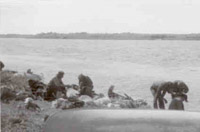 Before the first satellite dishes were installed in Fort Severn in the 1970s, and before community members were using any electronic communication technologies, they had different ways of exchanging information. These included travelling on foot and running to meet each other, dog sleds, leaving messages for each other on the trail, and writing and sending letters by post to people outside the community. The first electronic communication technologies included trail radios (radio phones) and satellite phones. All these early ways of communicating are described below.
Before the first satellite dishes were installed in Fort Severn in the 1970s, and before community members were using any electronic communication technologies, they had different ways of exchanging information. These included travelling on foot and running to meet each other, dog sleds, leaving messages for each other on the trail, and writing and sending letters by post to people outside the community. The first electronic communication technologies included trail radios (radio phones) and satellite phones. All these early ways of communicating are described below.
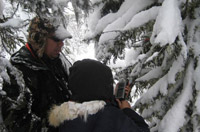 Travelling by foot and running
Travelling by foot and running
Before information and communication technologies arrived, Fort Severn community members would travel by foot between camps to exchange information when they were out on the land. There were also messengers that travelled from camp to camp to carry messages between them.
Some Fort Severn people were known as good runners. When there was an accident at one of the camps, someone would run for hours non-stop to get help. Back then, people in Fort Severn were very healthy because they were always moving, walking around, cutting wood for fuel, and so on.
One time, there was an emergency with a woman from the community who went into labour while she was out on the land. A young girl at the camp was asked to travel back to Fort Severn and bring the midwife back to the camp. She ran for hours to get her, and by the time the two returned to the camp, the birth was just starting and the midwife was able to help out.
Travelling by dog sled
Fort Severn community members used to have dog teams. When travelling they would not get on the sled but rather run beside, in front, or behind it. Some of the dogs were good husky dogs. People would visit each other traveling by dogs to deliver messages from one family to another.
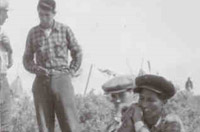 Exchanging messages on the trail
Exchanging messages on the trail
When they were out and on the land, community members sometimes used to leave messages for each other or letters on rocks or hanging on trees along the trails. For example, if there was a death somewhere, they would pass the news on that way.
Writing and sending letters by post
Back then, written mail was the main way that community members exchanged information with members of other communities. The post would travel by plane. At that time the planes did not arrive every day like today. Sometimes the planes would come weekly. A community member remembers hearing about a mailman who would walk for days to other communities to exchange the letters.
Field radios
Field radios, also called trail radios or citizens’ band, were popular with hunters and others out on the land. One person in a camp would be designated to have a field radio, and whenever anyone in the camp would have a message for another campground, they would ask that person to relay to it to that other campground.
With the field radio, after one person finished speaking, they would say “over,” indicating that their conversation was over and it is the other person's turn to talk.
People would also have their field radios at home. They would hear somebody talking and relay the message to other people in the community. After the community telephones came in, messages from people coming in by field radio would be relayed to others by telephone.
All the First Nation communities in the area used field radios. They used them to pass messages on from one community to another, all around the Hudson Bay coast, messages about how the hunting was, how the trapping was, sharing stories.
People enjoyed listening to others speaking on the field radio. Several people in Fort Severn still have trail radios for that reason, to know what's going on and to listen to other people talking. The languages spoken on the trail radio would be Cree and Ojibway. As one Fort Severn interview participant recalled: “Almost everybody that goes to the bush had those. They either owned them or rented. Wawatay Native Communications society used to rent them.”
A dramatic rescue using a trail radio
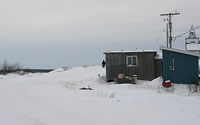 Fort Severn community member Joe Crowe is known for using a trail radio for a dramatic rescue. He and his brother-in-law went out to pick up their traps late in March one year. At the time, there was a helicopter doing exploration work along the coastline.
Fort Severn community member Joe Crowe is known for using a trail radio for a dramatic rescue. He and his brother-in-law went out to pick up their traps late in March one year. At the time, there was a helicopter doing exploration work along the coastline.
Joe and his buddy were gone about two or three days. The morning they were planning to return to Fort Severn it was snowing, pretty heavy snow, until noon. So they waited in the cabin for the snow to stop. When it stopped, Joe decided to go out and check around out the coastline before sundown.
It was a beautiful day, blue sky and no wind. So he decided to walk about a mile to the coastline.
When he got to the coast, he spotted something in the distance and went over to check it out. There was the helicopter, all in pieces. The passenger had been thrown out of the chopper and had a broken ankle. The pilot had bones sticking out from his leg. Joe and his buddy managed to set up a tent for them and drag them inside. They were in bad shape. They had crashed around 10 o'clock in the morning and Joe spotted them around sundown.
It was cold, minus 20 or 25, and Joe had a trail radio. He called into Fort Severn and told them exactly what had happened. A Hercules helicopter came by around two o'clock in the morning. Joe and his brother-in-law gave them a signal with their snow machines, circling around, and the paramedics parachuted down to that location, two or three of them with equipment, supplies and food. Both injured men survived!
Radio phones
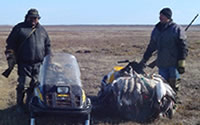 Radio phones were used in the past by community members and are still used in Fort Severn by the community police service. They work within a five to 10 kilometre radius of the radio tower, depending on the weather. They operate like a CB radio but connect people directly. A community member with an ordinary phone who calls into the Fort Severn police service will be connected with an officer’s radio phone. Sometimes this causes problems because they can be awkward to use if you’re not used to them; sometimes community members will think it’s an answering service and will hang up. The Fort Severn police service plans to get connected to the Keewaytinook Mobile service because they believe this will be a significant improvement to the current radio phone service.
Radio phones were used in the past by community members and are still used in Fort Severn by the community police service. They work within a five to 10 kilometre radius of the radio tower, depending on the weather. They operate like a CB radio but connect people directly. A community member with an ordinary phone who calls into the Fort Severn police service will be connected with an officer’s radio phone. Sometimes this causes problems because they can be awkward to use if you’re not used to them; sometimes community members will think it’s an answering service and will hang up. The Fort Severn police service plans to get connected to the Keewaytinook Mobile service because they believe this will be a significant improvement to the current radio phone service.
Satellite phones
Satellite phones were used primarily by hunters and trappers. They would carry them for emergencies, and some community members still use them for this reason. Other than for emergencies they are too expensive for most people to use. Even back in the 1970s, it cost about two dollars a minute. Satellite phones were simpler to use than the trail radios. There was no interference like on the trail radios.
Before home telephones came to Fort Severn in the early 1970s, the priest and the Hudson’s Bay Company manager had satellite phones. In case of emergency, community members would generally go to the priest, who would use his satellite phone to call outside the community for assistance.
